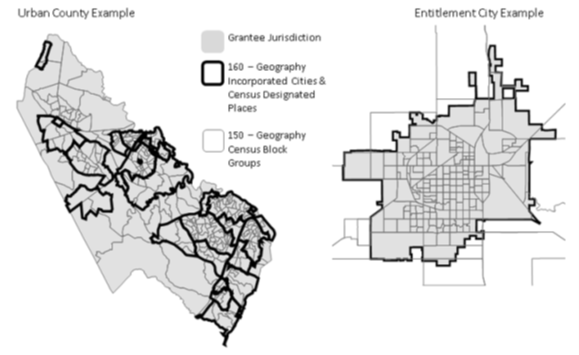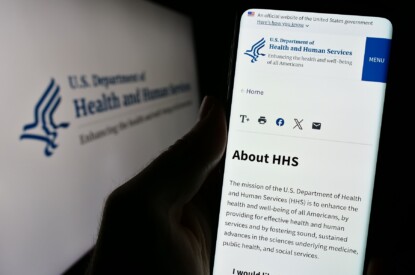Around every five years, HUD’s Community and Planning Development (CPD) office publishes a Notice to HUD grantees that contains guidance relating to U.S. geographic datasets used for compliance purposes with CDBG and other HUD programs.
The governing statute of HUD’s Community Development Block Grant (CDBG) program mandates that all funded activities, excluding program administration and planning, align with one of three national objectives. Among these, benefiting low- and moderate-income (LMI) persons constitutes the primary objective of the program. The governing CDBG statute requires that at least 70 percent of a grantee’s annual allocation be expended to benefit LMI persons.
HUD recently announced through CPD Notice 24-04 the release of low- and moderate-income summary data (LMISD) derived from the American Community Survey (ACS) 2016-2020 5-year estimates (2020 ACS). Alongside links to the new datasets, the Notice provides valuable information tailored for HUD grantees, particularly CDBG recipients. This includes the effective date for implementing the 2020 ACS LMISD to qualify for area-benefit (LMA) activities, a transition policy outlining exceptions to the effective date, and crucial guidance on the utilization of the new LMISD by HUD grantees.
LMA Activities
An area benefit activity is one that benefits all residents in a particular area, where at least 51 percent of the residents are low- to moderate-income (LMI) persons. These LMA activities are one of four categories of activities that can be used to meet the LMI national objective— the other three being limited clientele activities, housing activities, and job creation or retention activities.
The area benefit category is the most commonly used national objective for activities that benefit a residential neighborhood. Examples of acceptable LMA activities include construction of a community center, acquisition of land to be used for a park, drainage improvements in a neighborhood, and street improvements. An activity that serves an area that is not primarily residential in character does not qualify as an area-benefit activity.
Five-year estimates (e.g., 2016-2020) from the ACS (or survey data) are generally used by grantees and accepted by HUD to demonstrate compliance with the 51 percent threshold requirement for LMA activities. Data sets for the 2016-2020 period are now posted on the HUD Exchange webpage, along with several other resources to assist grantees with qualifying activities as area-benefit, including a basic two-step documentation process.
How to Use the 2020 ACS LMISD
HUD releases LMISD (low- and moderate-income summary data) in two primary formats: Summary Level 150 for block groups and Summary Level 160 for places, which encompass incorporated cities and unincorporated Census-designated places. Block groups are tailored to populations ranging from 600 to 3,000 individuals, whereas place geography corresponds to the jurisdictional boundaries of cities, towns, or other specified areas.
In rural areas, place geography often aligns with UGLG jurisdictions, facilitating the qualification of LMA (area-benefit) activities that benefit entire communities. This framework supports HUD’s goal of ensuring comprehensive coverage and effective targeting of resources in both urban and rural settings.

When defining a service area for activities, grantees should carefully consider several factors that influence geographic scope, referencing LMISD data accordingly:
- Nature of the Activity: The type and purpose of the activity should guide the selection of the service area.
- Location of the Activity: The specific geographic location where the activity will take place is crucial in determining its service area.
- Accessibility Issues: Considerations about how easily residents can access the services provided by the activity.
- Availability of Comparable Activities: Whether similar services are available in neighboring areas or if there is a gap that needs to be filled.
- Boundaries for Facilities and Public Services: The physical boundaries that define where facilities and public services are provided.
It is important for grantees to delineate service areas reasonably based on the intended beneficiaries of LMA activities. It is advisable to avoid combining place and block group data to define a single service area because these layers can overlap, potentially resulting in the double-counting of residents. Clear and distinct service area boundaries help ensure accurate targeting and effective deployment of resources.
Income Surveys
When the available LMISD geographies do not align appropriately with the intended service area, using LMISD to qualify an LMA activity may not be feasible. In such instances, grantees have the option to conduct a methodologically-sound local income survey to ensure compliance with LMA requirements specific to their service area. Similarly, if the service area does not initially qualify as LMA based on available data, conducting a local income survey can provide an alternative path to demonstrate qualification.
The HUD CDBG Income Survey Toolkit provides guidance on how to conduct methodologically-sound surveys and contains several resources, including a detailed guidebook, for recipients and subrecipients of CDBG funds. A best practice is to consult with HUD, however, prior to commencing a survey.
The LMI Summary Data Updates CPD Notice outlines guidelines for establishing confidence levels and margins of error (MOE) in local income surveys. The maximum allowable MOE for the local survey is determined as the lesser of 10 percent or the MOE associated with HUD-provided data for the equivalent geography. When service areas comprise multiple geographies, each individual geography will have its own distinct MOE, reflecting the specific characteristics and sampling methods used.
HUD Transition Policy
As per the CPD Notice, the transition to the 2020 ACS LMISD was August 1, 2024. Following updates to policies, HUD typically allows for continued use of existing data and rules under certain circumstances. In this case, if the 2015 ACS LMISD demonstrate compliance with LMA requirements for a specific geographic area, but the 2020 ACS LMISD do not, recipients may continue using the 2015 ACS LMISD under a four-part test. This test aims to ensure ongoing activities are not disqualified due to changes in data, which safeguards projects already in progress.
To qualify an LMA activity using the prior 2015 ACS LMISD, on or after August 1, 2024, the activity must meet each of the following four criteria:
- A documented action must have been made by the grantee before the effective date, August 1, 2024 (see CPD Notice for additional details relating to actions).
- The documented action must describe a specific activity.
- The documented action must describe a specific funding amount for the specific activity, and
- The specific activity must have a clearly defined LMI service area.
The LMI Summary Data Updates CPD Notice includes instructions on reporting LMA benefits in HUD’s Integrated Disbursement and Information System (IDIS) and the Disaster Recovery Grant Reporting (DRGR) System. Generally, grantees must indicate whether they used U.S. Census or survey data to determine compliance with the LMI national objective, as well as the dataset that was used.
Navigating the LMISD Updates
HORNE possesses the experience and subject matter expertise to assist your organization with navigating the requirements of HUD’s recent LMISD updates, including the following areas:
Policy Analysis
We stay current with HUD’s guidelines and updates related to LMISD, ensuring your organization remains compliant and well-informed. Our subject matter experts—several of whom previously worked for HUD—can analyze and advise on the applicability of the LMI Summary Data Updates CPD Notice to your organization’s programs and activities. We provide guidance on how to apply HUD’s four-part test effectively, enabling individual activities to meet the LMA national objective.
Implementation Support
We can assist with qualifying activities under the area benefit designation, including defining an appropriate service area and providing justification for the service area selected, documenting compliance, and designing programs that will ultimately meet the 70 percent LMI expenditure requirement specified in the Federal statute.
Documentation and Reporting
We assist in preparing accurate documentation and reports required by HUD, ensuring clarity and compliance in reporting LMA benefits in IDIS and DRGR systems. Our subject matter experts include members with over a decade of experience as primary administrators of HUD’s DRGR system in the Disaster Recovery and Special Issues Division (DSRI)—now known as the Office of Disaster Recovery (ODR). One HORNE team member directed every aspect of DRGR system development and implementation during his time at HUD.
For additional information on how HORNE can assist your organization with navigating the LMISD Updates contained in the CPD Notice, or how we can assist with national objective compliance more broadly, please contact us here.







